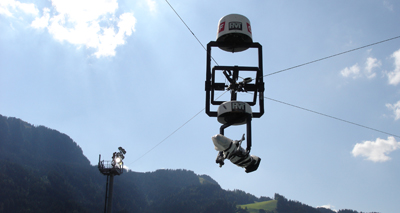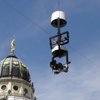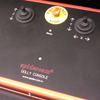
Spidercam (3D)
 The Spidercam operates using four motorized winches positioned at each corner of a designated area.
The Spidercam operates using four motorized winches positioned at each corner of a designated area.
Each winch controls a Kevlar cable connected to a gyro-stabilized camera dolly.
By controlling the winding and unwinding of the cables, the system allows the dolly to reach any position in the three dimensional space.
The inputs of the Spidercam "pilot" are processed by software that forwards the commands to the winches via fiber optic cables. Two of the Kevlar cables also have fiber optic cables woven into them to carry commands to the camera and the remote head, and bring the camera's high definition signal back to the control station. The remote head, which houses the camera, provides pan and tilt movement and includes the lens remote, which controls focus, zoom and iris.
A gyro sensor in the dolly stabilizes the horizon enabling amazingly smooth shots even at speeds of up to 8 meters per second. A specially trained Spidercam camera operator controls the camera.
![]() Please click here for a link through to the You Tube Spidercam Channel to view the Spidercam product range in action.
Please click here for a link through to the You Tube Spidercam Channel to view the Spidercam product range in action.
Specifications:
Winches:
- Standard Winch Size: 150cm x 90cm
- Standard Winch weight 350kg
- Split Winch: (special request) 150cm x 57cm and 80cm x 55cm
- Split Winch Weight: 150kg and 90kg
- Max Distance: 250m
- Max Speed: 8 meters per second
Requirements per winch:
- Space: 2m x 1,5m,flat ground, unobstructed way to the pulley above
- Power Supply: 400V-32A (3 Phase, PE, N) with CEE Plug; Power supply must be protected with an error-current circuit breaker
- During Operation the Winch has to be protected from unauthorised access (solid barrier or Security Personnel)
- Split Winch Weight: 150kg and 90kg
- Max Distance: 250m
- Max Speed: 8 meters per second
Pulleys:
- The Pulleys deflect the lifting cable from the winch to the camera dolly. Their positions define the Flying Area and Maximum Height. Every Pulley is mounted on a back-plate that can easily be fixed to substructures or Trusses with clamps or ratchet straps.
- Size Back Plate: 30cm x 30cm (Eurotruss Standard)
- Fully moveable in all three axis
- Pulley can take up Force up to 1.2 tons resulting in a 12-fold safety cushion
Specifications:
Requirements:
- Pulley can swing freely, has no contact with any obstacles
- Unobstructed Cable Way for the Lifting Cable from Pulley to Winch (no obstacle in the way, no moving parts in the immediate vicinity)
- Unobstructed Cable Way for the Lifting cable from Pulley to all possible Dolly positions
- Distance between Winch and Pulley 4 meters minimum
- Accesible Location for Setup / Dismantling
Control Station:
Specifications:
- Computer with Control Software and Safety Features
- Control Desks for spidercam® Dolly and Camera
- Monitors for Camera Operator and Pilot to follow spidercam® and program feed
- Intercom to communicate with director
- Emergency Power Supply prevents Operation disruption in case of Power Loss
Requirements:
- Min Space 3m x 2,5m for Control Station and Crew
- Unobstructed View of the entire Flying Area from the Control Station
- Power Supply: 230V – 16A (1 phase, PE, N)
Signal Connection:
- 1x BNC HD-SDI (Spidercam® picture)
- 1x BNC HD-SDI (Program picture)
- 1x XLR 3 pin (camera data)
- 2x XLR 3 pin (Intercom)
- 1x XLR 3 pin (Tally)
Camera
The spidercam® Dolly is not restricted to a single camera type, but can be equipped with various cameras. Our rental systems usually use Full-HD Panasonic Cameras, but there are also systems with Sony cameras or special 35mm adaptions.
Specification:
Panasonic AK-HC 1500G: 2/3 inch 3-CCD Chip, Bayonet mount supported
Lens
Not only the camera choice is flexible, you can also use different lenses on the spidercam®. Generally we use wide-angle lenses from Canon or Fujinon for the best results:
- Fujinon HA13x4,5BERD 48B wide angle
- Canon HJ11ex4,7B wide angle
- Canon HJ14ex4,3B super wide angle



